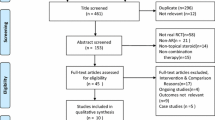Abstract
A new topically administered intranasal antiallergic drug, azelastine, was investigated in a large randomized multicenter study that compared it with oral cetirizine from the aspects of efficacy and safety. Patients were treated for 14 days, and efficacy was assessed on days 7 and 14 by means of an investigator rating scale measuring the severity of eight nasal and ocular symptoms of seasonal rhinitis. In addition, patients recorded the extent of individual symptoms on a visual analogue scale (VAS). Tolerability was assessed on the basis of adverse events reported. Data from a total of 129 patients were included in the analysis of drug efficacy. Treatment groups had significant reductions in the investigators' total symptom score during treatment. These reductions were 47% and 55% for azelastine and cetirizine, respectively, at day 7 and 61% and 67% at day 14. There were no differences between the two groups whether they were analyzed overall or separately for nasal and ocular symptoms. Patients' daily VAS scores showed a significantly better resolution of nasal stuffiness and rhinorrhea in the azelastine-treated group than in the cetirizine-treated group. There were no differences for any other symptom. Adverse events were reported by 12 patients in the azelastine group and 20 patients in the cetirizin group. Drowsiness was the only frequently occurring event and this was in the azelastine group (P = 0.003).
Similar content being viewed by others
References
Chand N (1986) Antagonism of histamine and leukotrienes by azelastine in isolated guinea pig ileum. Agents Actions 19:164–168
Chand N, Harrison JE, Rooney SM, Sofia RD, Diamantis W (1985) Inhibition of passive cutaneous anaphylaxis (PCA) by azelastine: dissociation of its antiallergic activities from antihistaminic and antiserotonin properties. Int J Immunopharmacol 7: 833–838
Diamantis W, et al (1981). In vivo and in vitro Hl antagonist properties of azelastine. Pharmacologist 23:149
Gambardella R (1993) A comparison of the efficacy of azelastine nasal spray and loratidine tablets in the treatment of seasonal allergic rhinitis. J Int Med Res 21:268–275
Gastpar H, Aurich R, Petzold U, et al (1993) Azelastine nasal spray for topical treatment of allergic rhinopathy. Atemwegs Lungenkr 19:148–154
Gastpar H, Aurich R, Petzold U, Dorow P, et al (1993) Intranasal treatment of perennial rhinitis. Arzneimittelforschung/ Drug Res 43:475–479
Linder A (1988) Symptom scores as measures of the severity of rhinitis. Clin Allergy 18:29–37
Passali D, Pirigine F (1994) A comparison of azelastine nasal spray and cetirizine tablets in the treatment of perennial rhinitis. J Int Med Res 22:17–23
Author information
Authors and Affiliations
Rights and permissions
About this article
Cite this article
Charpin, D., Godard, P., Garay, R.P. et al. A multicenter clinical study of the efficacy and tolerability of azelastine nasal spray in the treatment of seasonal allergic rhinitis: a comparison with oral cetirizine. Eur Arch Otorhinolaryngol 252, 455–458 (1995). https://doi.org/10.1007/BF02114749
Received:
Issue Date:
DOI: https://doi.org/10.1007/BF02114749




